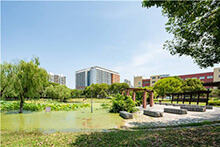浙江大學公共管理學院導師:韓昊英

浙江大學公共管理學院導師:韓昊英內容如下,更多考研資訊請關注我們網站的更新!敬請收藏本站,或下載我們的考研派APP和考研派微信公眾號(里面有非常多的免費考研資源可以領取,有各種考研問題,也可直接加我們網站上的研究生學姐微信,全程免費答疑,助各位考研一臂之力,爭取早日考上理想中的研究生院校。)
微信,為你答疑,送資源

浙江大學公共管理學院導師:韓昊英 正文
姓名:韓昊英
性別:男
所在學院:公共管理學院
職稱:副教授
個人簡介:
男,1978年生,博士,浙江大學公共管理學院副教授,院工會副主席,土地資源管理專業研究生德育導師。
1996-2001年就讀于清華大學建筑學院建筑系,獲建筑學學士學位。
2001-2004年就讀于清華大學建筑學院城市規劃系,獲工學碩士學位。
2004-2007年獲得日本政府文部科學省獎學金資助,就讀于日本東京大學都市工學系,進行城市土地利用規劃和增長管理問題的研究。
2007年獲博士學位,同年10月進入浙江大學公共管理學院土地管理系工作。
曾作為課題組成員和“中國篇”研究負責人,參與編寫由日本國土交通省委托,財団法人土地総合研究所組織的“平成17年(2005年)國土交通省土地政策研究報告——亞洲諸國土地利用相關調查(アジア諸國における土地利用に関する調査) ”;
并主持中國國家自然科學基金項目“基于決策網絡的城市用地擴展管理模式研究(項目編號:50908200/E080201,2010—2012年)”、錢江人才計劃項目“基于決策網絡的城市用地擴展管理規劃支持系統的技術和方法研究(2010—2012年)”、中國博士后科學基金一等資助項目“多層次城市用地增長管理政策評價模式研究(項目編號:20080430210,2008—2009年)”、教育部留學回國人員啟動基金“城市土地集約利用的空間規劃模式研究——以浙江省為例”(項目編號:J20091217,2009—2010年)和浙江省教育廳科研項目“浙江省城市緊湊度研究(項目編號:Y200805587,2008—2009年)”;
參與過中國國家自然科學基金項目“農地非農化治理效率評價及政策仿真研究(項目編號:70903057/G0305,2010—2012年)”、中國國家自然科學基金項目“面向數字城市規劃的空間信息技術集成應用模式研究(項目編號:50678088)”、北京市自然科學基金項目“基于空間信息技術的北京市動態發展機理與調控研究(項目編號:4063038)”,以及清華大學985基礎研究基金項目“數字城市總體規劃方法研究(項目編號:JC2001002)”的研究和編寫工作。
論文《日本1968年城市規劃法劃線制度的實施成效及其政策啟示》獲中國城市規劃學會和金經昌城市規劃教育基金會聯合頒發的“2009年金經昌中國城市規劃優秀論文獎(佳作獎)”。
目前主要研究動向:
[1] 復雜與城市發展和空間規劃
[2] 決策網絡
[3] 規劃分析
[4] 空間句法與人類行為模式
碩士生課程:
[1]吳次芳, 韓昊英. 區域發展與空間規劃
[2]韓昊英, 楊遴杰. 城市管理(MPA課程)
學術成果:
主要論文:
1.期刊論文:
[1] Han, Haoying, and Shih-Kung Lai. Decision Network: A Planning Tool for Making Multiple, Linked Decisions. Environment and Planning B: Planning and Design. 2011, 38(1): 115-128. SSCI/SCI/EI [DOI: 10.1068/b35158]
[2]賴世剛, 韓昊英*, 于如陵, 柯博晟. 都市聚落系統的形成規律——遞增報酬與冪次法則的計算機與數理仿真. 地理學報, 2010, 65(8): 961-972.
[3]韓昊英, 龍瀛. 綠色還是綠地——北京市第一道綠化隔離帶實施成效研究. 北京規劃建設, 2010(3): 59-63.[ISSN: 1003-627X]
[4]賴世剛, 韓昊英, 吳次芳. 行為規劃理論芻議. 浙江大學學報(人文社會科學版), 2010, 40(2): 89-97. [DOI: 10.3785/j.issn. 1008-942X.2009.08.071]
[5]黃輝玲, 韓昊英*, 吳次芳, 徐金哲. 哈爾濱市經濟適用住房現狀調查與分析.現代城市研究, 2009, 24(12): 21-27.(ISSN: 1009-6000)
[6]賴世剛, 韓昊英*, 吳次芳. 城市管理的學科設計——架構與內涵. 公共事務評論(臺灣), 2009, 10(2): 35-72. (ISSN: 1608-9456)
[7]韓昊英, 賴世剛, 吳次芳. 中國當代城市規劃的戰略觀——復雜城市系統中設計與戰略型規劃的解析. 浙江大學學報(人文社會科學版), 2009, 39(6): 187-194. [DOI: 10.3785/j.issn. 1008-942X.2009.02.221]
[8] Han, Haoying, Shih-Kung Lai, Anrong Dang, Zongbo Tan, and Cifang Wu. Effectiveness of Urban Construction Boundaries in Beijing: An Assessment. Journal of Zhejiang University SCIENCE A. 2009, 10(9): 1285-1295. SSCI/SCI/EI[DOI: 10.1631/jzus.A0920317]
[9]吳次芳, 韓昊英, 賴世剛. 城市空間增長管理:工具與策略. 規劃師, 2009, 25(8)15-19.
[10]龍瀛, 韓昊英*, 毛其智. 利用約束性CA制定城市增長邊界. 地理學報, 2009, 64(8): 999-1008.[ISSN: 0375-5444]
[11]韓昊英, 黨安榮, 吳次芳, 馮科. 基于遙感影像的北京市城市規劃區內農用地控制成效分析. 中國土地科學, 2009, 23(5): 59-64.
[12]韓昊英, 馮科, 吳次芳. 容納式城市發展政策:國際視野和經驗. 浙江大學學報(人文社會科學版), 2009, 39(2): 162-171.[ DOI:10.3785/j.issn.1008-942X.2009.02.019]
[13] Lai, Shih-Kung, and Haoying Han*. Compensation Policies for Agricultural Land Requisition in China: A Review. Review of Real Estate and Urban Studies. 2009(2): 123-134.
[14]馮科, 吳次芳, 韓昊英. 國內外城市蔓延的研究進展及思考——定量測量、內在機理及其調控策略. 城市規劃學刊, 2009(2): 38-43.
[15]吳一洲, 陳前虎, 韓昊英, 羅文斌. 都市成長區城鎮空間多元組織模式研究. 地理科學進展. 2009, 28(1): 103-110.
[16]韓昊英. 日本1968年城市規劃法劃線制度的實施成效及其政策啟示. 北京規劃建設, 2008(2): 81-85.
[17]黑瀨武史, 韓昊英. 后工業化國家傳統工業區改造中的環境治理——對于日本、美國和歐洲經驗的綜合回顧. 北京規劃建設, 2007 (2): 80-83.
[18]韓昊英, 李蕊芳, 希巴·鮑·阿卡爾等. 城市校園.世界建筑. 2005(3): 30-32.
[19]韓昊英. 基于RS和GIS技術的北京舊城傳統街區的數量分析. 北京規劃建設, 2005 (4): 25-28.
2.國際會議論文
[1] Han, Haoying, and Shih-Kung Lai. Formation of National Land Policies in China: Processes and Effectiveness. Symposium of Comparing Urban and Environmental Issues in China and the U. S., East Lancing, USA, 2011.
[2] Lai, Shih-Kung, Haoying Han. Planning as Intelligence. 2010 International Symposium on Urban Planning. Nara, Japan, 2010.
[3] Han, Haoying, The Paradise in China: Modern Development and Heritage Conservation of Hangzhou. The International Policy Forum on Urban Growth and Conservation in Euro-Asian Corridor. Istanbul, Turkey, 2010.
[4] Han, Haoying, and Shih-Kung Lai. Urban Land Inventory Management: Exploration of the Costs. The 15th Inter-University Seminar on Asian Megacities. Tokyo, Japan, 2010.
[5] 韓昊英, 賴世剛. 以財產權觀點探討中國土地一級市場制度. 第二屆東亞房地產研討會. 日本大學, 東京, 2009.
[6] Han, Haoying, and Shih-Kung Lai. Urban Land Inventory Management: a Comparison between Time-driven and Even-driven Methods. International Forum on Sustainable Urbanization. Calumet, USA, 2009.
[7] Ye, Yanmei, Xiaomin Ye, and Haoying Han. Concept Clarification and Classification for Idle Land. The CRIOCM 2009 International Symposium on Advancement of Construction Management and Real Estate. Nanjing, 2009.
[8] Huang, Huiling, Haoying Han, Cifang Wu, and Jinzhe Xu. Survey and Analysis of the Affordable Housing in Harbin City. The CRIOCM 2009 International Symposium on Advancement of Construction Management and Real Estate. Nanjing, 2009.
[9] Han, Haoying, and Shih-Kung Lai. The Power Law of Urban Settlements: An Empirical Study of China. The 2009 International Workshop of Urban Geography, Beijing, 2009.
[10] Lai, Shih-Kung, and Haoying Han. Decision Network: Toward A Planning Support System. in the Proceedings of the 11th International Conference on Computers in Urban Planning and Urban Management. Hong Kong, 2009.
[11] Han, Haoying. Sustainable Development in Hangzhou: Its Gain and Loss toward a “Mordernized” City. Lecture at the International Workshop on Sustainability. Tokyo, 2009.
[12] 韓昊英. 中國經濟適用房政策的發展沿革. 第一屆東亞房地產研討會. 建國大學, 首爾, 2008.
[13] 黃輝玲, 韓昊英. 哈爾濱市經濟適用住房現狀調查與分析. 第八屆中韓土地政策研討會. 韓國國土研究院, 首爾, 2008.
[14] Han, Haoying, and Anrong Dang. Assessment of the Implementation of Urban Construction Boundaries in Beijing City by Using Remote Sensing Data. in the 16th International Conference on Geoinformatics & Joint Conference on GIS and Built Environment. Guangzhou, 2008.
[15] Han, Haoying, and Yukio Nishimura. Urban Land Growth and Its Management in China—The Contemporary Approaches. in the Proceedings of the 12th International Planning History Society. New Delhi, India, 2006.
[16] Han, Haoying, and Yukio Nishimura. Central Government’s Role in Urban Land Growth Management—The Perspective in China. in the Proceedings of the 2nd World Planning Schools Congress. Mexico City, Mexico, 2006.
[17] Dang, Anrong, Huizhen Shi, Haoying Han et al. Study on the System of Technical Methods for Digital Urban Planning. in the Proceedings of the International Society for Photogrammertry and Remote Sensing. Hangzhou, 2005.
[18] Han, Haoying. Incompatible or Reciprocal? The Policies of Urbanization and Cultivated Land Protection of China. in the Proceedings of the 8th International Asian Planning Schools Association Congress. Penang, Malaysia, 2005.
[19] Han, Haoying. The Operation of Control in the Cultivated Land Protection System of China. in the Proceedings of the 10th Inter-University Seminar on Asian Megacities. Khabarovsk, Russia, 2005.
[20] 韓昊英, 鄧奕, 史慧珍. 歷史文化保護區確立初期北京舊城形態特征及變遷初探. 中國建筑學會50周年年會. 北京, 2003.
[21] Han, Haoying, and Zongbo Tan. Case Study: A Survey on Residential Land Use Condition and Its Planning in Xian-Ju City, Zhejiang Province, P. R. China. in the Proceedings of the 8th Inter-University Seminar on Asian Megacities. Beijing, 2003.
[22] Han, Haoying, and Zongbo Tan. Urban Land Use Planning and Management of Small Cities in China. in the Proceedings of the 7th Inter-University Seminar on Asian Megacities. Manila, Philippines, 2002.
3.著作
[1]賴世剛, 韓昊英. 復雜: 城市規劃的新觀點. 北京: 中國建筑工業出版社, 2009.
工作研究領域:
城市土地利用規劃與控制,城市增長管理,城市與復雜
“如果發現導師信息存在錯誤或者偏差,歡迎隨時與我們聯系,以便進行更新完善。”
添加浙江大學學姐微信,或微信搜索公眾號“考研派小站”,關注[考研派小站]微信公眾號,在考研派小站微信號輸入[浙江大學考研分數線、浙江大學報錄比、浙江大學考研群、浙江大學學姐微信、浙江大學考研真題、浙江大學專業目錄、浙江大學排名、浙江大學保研、浙江大學公眾號、浙江大學研究生招生)]即可在手機上查看相對應浙江大學考研信息或資源。


浙江大學
本文來源:http://m.btfokj.cn/zhejiangdaxue/daoshi_481948.html
推薦閱讀
-

浙江大學化學系研究生導師:林峰
姓名:林峰單位:化學系職稱:副教授個人簡介原杭州大學獲理學學士學位麗水學院化學系任教原杭州大學獲理學碩士學位北京大學獲理學博士學位現在浙江大學化學系任教工作研究領域生物無機……
日期:10-07 閱讀量:20 -

浙江大學化學系研究生導師:劉潤
姓名:劉潤單位:化學系職稱:副教授基本信息個人簡介教育背景:華東理工大學化學系獲學士學位()華東理工大學物理化學專業獲碩士學位()密蘇里羅拉大學()化學系獲博士學位并作博士……
日期:10-07 閱讀量:20 -

浙江大學化學系研究生導師:劉占祥
姓名:劉占祥單位:化學系職稱:副教授,碩士生導師基本信息個人簡介劉占祥,博士,副教授。年畢業于西北師范大學化學系年獲有機化學碩士學位年浙江大學化學系獲博士學位。中國科學院化……
日期:10-07 閱讀量:20 -

浙江大學化學系研究生導師:聶晶晶
姓名:聶晶晶單位:化學系職稱:副教授個人簡介年本科畢業于浙江大學化學系,獲理學學士學位;年浙江大學化學系應用化學專業碩士研究生,從事聚醚和聚環氧乙烷的合成和改性研究,于年月……
日期:10-07 閱讀量:20 -

浙江大學化學系研究生導師:王國平
姓名:王國平單位:化學系職稱:副教授基本信息個人簡介浙江大學化學系碩士(年月)、博士(年月);年月至今,在浙江大學化學系任教;年月年月,在美國(布魯克海文國家實驗室)訪問。……
日期:10-07 閱讀量:20 -

浙江大學化學系研究生導師:吳金龍
姓名:吳金龍單位:化學系職稱:副教授基本信息個人簡介學習簡歷:年月年月杭州大學,理學學士;年月年月杭州大學,理學碩士;年月年月杭州大學(年月年月香港科技大學),理學博士。工……
日期:10-07 閱讀量:20 -

浙江大學化學系研究生導師:習玲玲
姓名:習玲玲單位:化學系職稱:副教授基本信息個人簡介現任浙江大學化學系副教授。杭州大學化學系分析化學碩士畢業,至今相繼在浙江大學藥學院和化學系任教,浙江大學化學系分析化學博……
日期:10-07 閱讀量:20 -

浙江大學化學系研究生導師:姚加
姓名:姚加單位:化學系職稱:副教授基本信息個人簡介年月畢業于浙江大學化學系,獲得理學學士學位;年月到年月在化學系物理化學專業讀研究生,師從韓世鈞教授,于年月獲得博士學位;年……
日期:10-07 閱讀量:20 -

浙江大學化學系研究生導師:趙華絨
姓名:趙華絨單位:化學系職稱:副教授個人簡介浙江大學博士;美國訪問學者工作研究領域科研方向:有機化學、有機合成科研內容:新型雜環化合物的合成及活性分析。含硒(硫)化合物的合……
日期:10-07 閱讀量:20 -

浙江大學化學系研究生導師:祝瑩
姓名:祝瑩單位:化學系職稱:特聘副研究員,碩士生導師基本信息個人簡介至今浙江大學,化學系,特聘副研究員,碩士生導師浙江大學,控制系,智能系統與控制研究所,博士后(導師,方群……
日期:10-07 閱讀量:20 -

浙江大學金融學導師:王義中
微軟雅黑宋體個人簡介王義中性別:男職稱:副教授出生年月:手機:電子郵箱:微軟雅黑宋體主要著作、論文理解人民幣匯率的均衡、失調、波動與調整,經濟研究,年第期。宏觀經濟不確定、……
日期:10-07 閱讀量:20 -

浙江大學金融學導師:楊柳勇
微軟雅黑宋體個人簡介楊柳勇性別:男所在學院:經濟學院職稱:教授職務:系主任出生年月:手機:電子郵箱:浙江大學管理學博士,韓國首爾大學訪問教授和博士后研究。專業方向為國際金融……
日期:10-07 閱讀量:20 -

浙江大學金融學導師:楊曉蘭
微軟雅黑宋體個人簡介楊曉蘭性別:女所在學院:經濟學院職稱:副教授出生年月:手機:聯系電話:電子郵箱:學術專長與興趣:行為金融、實驗金融、證券市場研究。微軟雅黑宋體個人簡歷年……
日期:10-07 閱讀量:20 -

浙江大學金融學導師:鄒小芃
微軟雅黑宋體個人簡介鄒小芃性別:男所在學院:經濟學院職稱:教授職務:副所長出生年月:手機:聯系電話:電子郵箱:微軟雅黑宋體個人簡歷年杭州大學數學系本科畢業年上海市社科院獲經……
日期:10-07 閱讀量:20 -

浙江大學金融學導師:黃燕君
微軟雅黑宋體個人簡介黃燕君性別:女所在學院:經濟學院職務:金融研究所副所長職稱:教授出生年月:手機:電子郵箱:主要研究領域及專長為國際金融、金融理論與政策,在金融學界有一定……
日期:10-07 閱讀量:20 -

浙江大學金融學導師:馬良華
微軟雅黑宋體個人簡介馬良華性別:男所在學院:經濟學院職稱:教授職務:研究所副所長出生年月:手機:聯系電話:電子郵箱:微軟雅黑宋體個人簡歷年獲得浙江大學管理學院管理學博士學位……
日期:10-07 閱讀量:20 -

浙江大學金融學導師:何嗣江
微軟雅黑宋體個人簡介何嗣江性別:男所在學院:經濟學院職稱:副教授出生年月:年月手機:電子郵箱:微軟雅黑宋體個人簡歷,安徵師范大學數學系本科畢業,獲理學士學位,安徽南陵師范學……
日期:10-07 閱讀量:20 -

浙江大學金融學導師:景乃權
微軟雅黑宋體個人簡介景乃權性別:男職務:浙大江萬齡金融投資中心副主任兼秘書長職稱:副教授出生年月:手機:聯系電話:電子郵箱:在校學習年、歐洲留學年、銀行工作年、浙大教書年,……
日期:10-07 閱讀量:20 -

浙江大學金融學導師:劉春杰
微軟雅黑宋體個人簡介劉春杰性別:女所在學院:經濟職稱:副教授出生年月:微軟雅黑宋體個人簡歷年,副教授年,碩士生導師微軟雅黑宋體主要著作、論文已出版著作部發表論文余篇微軟雅黑……
日期:10-07 閱讀量:20 -

浙江大學金融學導師:羅德明
微軟雅黑宋體個人簡介羅德明性別:男所在學院:經濟學院職稱:副教授出生年月:手機聯系電話電子郵箱年,畢業于英國倫敦大學。主要興趣是應用經濟學,包括金融,制度,與發展經濟學。……
日期:10-07 閱讀量:20





























